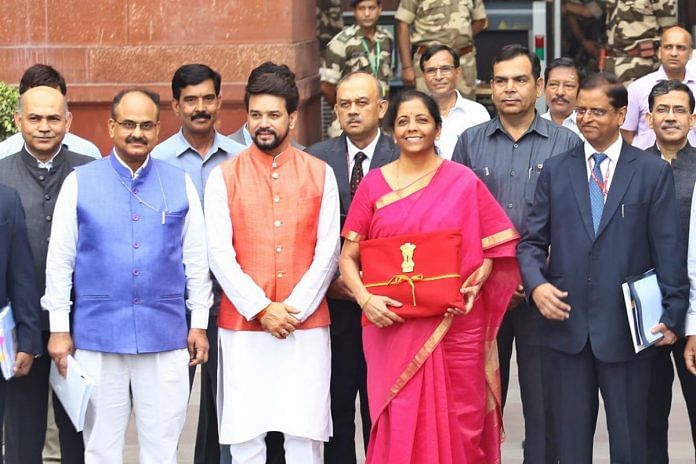The key elements of the fiscal arithmetic that enabled Finance Minister Nirmala Sitharaman to reduce the fiscal deficit to 3.3 per cent of the GDP can be highlighted by comparing the Budget estimates with those of the interim Budget for 2019-20.
The main changes reflect a reduction in both direct and indirect tax estimates. The Centre’s net tax revenue estimate in the full year Budget was lower by 3.3 per cent as compared to the level in the interim Budget for 2019-20. Non-tax revenues, on the other hand, have been increased by 14.9 per cent. Together, these amount to a fall of a little less than 1 per cent in the Centre’s net revenue receipts.
On the capital side, non-debt capital receipts have been increased by 16.7 per cent over the interim Budget estimates. These changes have led to an increase in the revenue deficit from 2.2per cent of the GDP in the interim Budget to 2.3 per cent in the full year Budget and a fall in the fiscal deficit from 3.4 per cent to 3.3 per cent of the GDP. Together, these adjustments have resulted in capital expenditure relative to GDP remaining unchanged at 1.6 per cent. This is a relatively small contribution to the required investment rate of more than 36 per cent for India to achieve a real GDP growth rate of 8 per cent.
Also read: Budget 2019 will boost growth only if Modi govt is friendly towards business and profits
Achieving a $5 trillion economy
Pushing the Indian economy to a size of $5 trillion by 2024-25 depends on real growth rate, inflation rate and the movement of Indian rupee vis-à-vis the US dollar. Starting with a base size of $2.7 trillion in 2018-19, if annual growth is uniformly distributed across the next five years, a nominal growth rate of 13 per cent per annum is required, which can be decomposed into a real growth of 8-9 per cent and an inflation rate of 5-4 per cent with an assumed rate of depreciation on the Indian rupee of 2 per cent per annum.
Uplifting growth by a margin of 1.2 percentage points from 6.8 per cent in 2018-19 to 8 per cent in 2019-20 and beyond requires increasing the investment rate by a margin of 5 percentage points to about 36 per cent from its present level of 31.3 per cent. This is based on an incremental capital-output ratio of about 4, which is derived as an average for the period 2016-17 to 2018-19.
Such an increase in investment is not expected to come from the central government alone. The main constraint is the stagnant tax-GDP ratio of the Centre, which is projected in the range of 11.6-11.7 per cent for the next few years. However, the central government has been relying, to a substantive extent, on the Central Public Sector Enterprises (CPSEs) and Special Purpose Vehicle (SPVs) for infrastructure investment. In 2018-19, the capital expenditure undertaken by CPSEs amounted to 2.4 per cent of the GDP. This is estimated to fall to 2.1 per cent of the GDP in 2019-20. So, the incremental investment effort is not expected to come from this source.
The two other sources of investment are private sector and the state governments, who can be co-opted in the framework of cooperative federalism to expand their investment programmes. Given that the state governments are also subject to the Fiscal Responsibility and Budget Management Act limits, we may not expect an increase of more than 1 percentage point of the GDP from them. The balance of 4 percentage points of the GDP of the required increase in investment needs to, therefore, come from the private sector.
Also read: Zero-budget farming: Why Budget 2019 isn’t in sync with PM Modi’s promises to farmers
Growth-promoting budgetary initiatives
The Union Budget has proposed a number of growth-promoting initiatives to induce the private sector to participate actively in uplifting the investment rate. The Narendra Modi government proposes to access global investors by floating sovereign bonds denominated in external currency. This will ease pressure on domestic savings and interest rates, which will eventually facilitate the effective transmission of a repo rate reduction to lending rates. There is also a clearer focus on Make in India, where the emphasis will now be on relatively limited sectors such as MSMEs, startups, defence manufacturing, automobiles, and electronics.
Further, the government aims to invite global investors for setting up mega-manufacturing plants to bring in advanced technology in electric vehicles, electronics and other related areas. The burden of non-performing assets (NPAs) on the banking sector is likely to ease with a budgeted capital infusion of Rs 70,000 crore.
The Budget has also announced that non-banking financial companies (NBFCs) would also be allowed to access the facility currently available to banks, wherein interest on bad loans paid by loss-making entities is taxed in the year in which it is actually received.
Also read: Sitharaman’s Budget speech was low on political buzzwords, & this was a message from Modi
Most importantly, the government has shown its inclination to reinvigorate public-private partnerships for its ambitious infrastructure expansion plans. An expert committee is proposed to be set up to examine the scope for long-term financing of infrastructure and recommend methods for doing so.
Whether these initiatives will translate into a substantive increase in the private sector’s investment rate depends on the pace and effectiveness of the implementation of these initiatives. It can be expected that India’s growth rate may increase to 7 per cent in 2019-20 as indicated by the Economic Survey. It will then have to be increased further to over 8 per cent in subsequent years for India to become a $5 trillion economy within the stipulated duration of five years.
The author is the Chief Policy Advisor, EY India and formerly Director, Madras School of Economics. Views expressed are personal.






